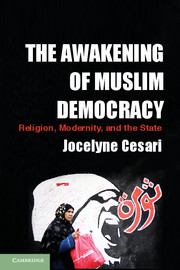Book contents
- Frontmatter
- Contents
- Acknowledgments
- Preface
- Part I THE MAKING OF ISLAM AS A MODERN RELIGION
- 1 Modernization and Politicization of Religion
- 2 Nation-State Building and the Inclusion of Muslim Polities within the Westphalian Order
- 3 Islam in the Constitution
- 4 Nationalization of Islamic Institutions and Clerics
- 5 Islam in the Legal System
- 6 Teaching Islam in Public Schools
- Part II ISLAMISM AS THE PREEMINENT POLITICAL FORCE PRE– AND POST–ARAB SPRING
- Part III THE DISJUNCTION OF DEMOCRACY AND SECULARISM – LESSONS LEARNED FROM THE ARAB SPRING
- Appendix I Religious Violence Index
- Appendix II Egyptian Constitution, Ratified on December 26, 2012. Suspended on July 3, 2013
- Bibliography
- Index
- References
4 - Nationalization of Islamic Institutions and Clerics
Published online by Cambridge University Press: 05 July 2014
- Frontmatter
- Contents
- Acknowledgments
- Preface
- Part I THE MAKING OF ISLAM AS A MODERN RELIGION
- 1 Modernization and Politicization of Religion
- 2 Nation-State Building and the Inclusion of Muslim Polities within the Westphalian Order
- 3 Islam in the Constitution
- 4 Nationalization of Islamic Institutions and Clerics
- 5 Islam in the Legal System
- 6 Teaching Islam in Public Schools
- Part II ISLAMISM AS THE PREEMINENT POLITICAL FORCE PRE– AND POST–ARAB SPRING
- Part III THE DISJUNCTION OF DEMOCRACY AND SECULARISM – LESSONS LEARNED FROM THE ARAB SPRING
- Appendix I Religious Violence Index
- Appendix II Egyptian Constitution, Ratified on December 26, 2012. Suspended on July 3, 2013
- Bibliography
- Index
- References
Summary
The modern nation-state supplies public services previously offered by religious institutions, such as court systems, education, and social welfare. As a result, the state came to effectively control and reform Islamic institutions and to harness their social influence as a political instrument to legitimize and/or promote its vision and interests through nationalization. During these consolidation efforts, the independent institutions of waqf and madrasa (religious foundations and Islamic schools) were the first to come under state control.
To explain how the state came to control religious institutions as part of the nation-building project, Ali Dessouki offers “four methods of subordination”: the elimination of religious institutions’ independent sources of income; administrative reorganization of the institutions and structural changes; the abolishment or integration of the Shariʿa courts into a national court system; and the integration and absorption of religious education into the national educational system. Importantly, in all cases, the state nationalized previously independent Islamic institutions and absorbed their leaders under state ministries, often transforming clerics into civil servants. This chapter addresses the nationalization of Islamic institutions, and the following two chapters address the state-run legal and educational systems.
NATIONALIZATION OF RELIGIOUS ENDOWMENTS AND APPROPRIATION OF RELIGIOUS LEGITIMACY
In Pakistan, starting in the 1960s under Ayub Khan (1958–69), the state brought religious foundations and major shrines under the administration and centralized control of the Department of Religious Endowments and the Advisory Council for Islamic Ideology. In 1959, the West Pakistan Waqf Properties Ordinance enabled the government to take control of and manage shrines, mosques, and all waqf properties, including agricultural lands, shops, houses, and temporary lodging sites. To extend the authority of the Department of Religious Endowments, similar acts were passed in 1961 and in 1976. These Auqaf acts were “intended to undercut the political power of both the hereditary pir families (the sajjada-nishins, or hereditary administrators) and the ulama.” This also included changing the significance of the shrines and of the saints affiliated with them. Ayub redefined these Islamic institutions not only by integrating their functions into the state administration but also by establishing state involvement in their management.
- Type
- Chapter
- Information
- The Awakening of Muslim DemocracyReligion, Modernity, and the State, pp. 49 - 59Publisher: Cambridge University PressPrint publication year: 2014



